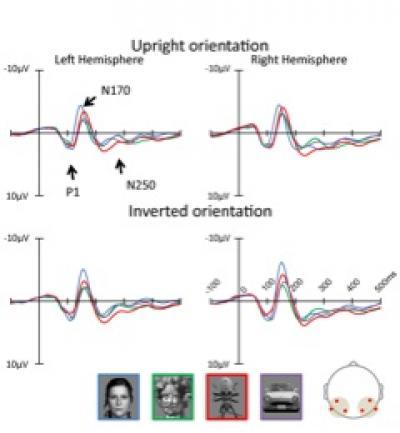Humans sometimes perceive an inherently meaningless object such as a pattern, landscape or object as another object, one that has meaning. It's why alternative science proponents, the Jeffrey Smith's and Pete Myers of the world, believe in spirit photographs.
Some have even argued that pareidolia occurs in relatively low-level visual processing, and a new paper examines the relation between behavior when a face-like object is viewed and brain activity to reveal the level of visual processing at which face-likeness is recognized.
Visual processing of the human face is divided into three different stages. The first stage is early visual processing of roughly identifying the object. Then, if the object is a face, distinguishing the parts of the face (eyes, nose, mouth) from one another and processing the outline and parts of the face. Lastly, expression and individual differences are distinguished.

The brain when a face-like object is viewed.Credit: Toyohashi University of Technology.
The authors studied the relation between activity at these three stages of processing and the results of actual recognition and determined that face-likeness recognition occurs in the first stage of visual processing. This processing occurs at a speed of approximately 100 milliseconds after viewing an object, and they believe that face-likeness processing occurs before we are aware of the object.
They hope the results of this study are believed to serve as a key to uncovering the mechanism of how humans recognize and distinguish between two types of information - "face-likeness" and objects. The results of the present study also suggest that "face-likeness" recognition occurs in early visual processing and that face-like objects are processed in the same manner as a human face in later stages.






Comments